Welcome back to our exploration of music intervals. In this article, we'll uncover the secrets behind these essential components of melodies and harmonies. Join us in the world of intervals as we learn to recognize their distinct characteristics and deepen our appreciation of their role in music.
As always, I encourage you to practice everything we discuss on your instrument, preferably on a keyboard. If you do not have access to a keyboard, you can use the touch keyboard available in Flat.
🚀 Let's begin this exciting journey!
What are intervals in music theory?
Intervals in music represent the distance between 2 notes, which defines the dynamic relationships and interactions within a musical composition.
For example, the distance between C and A can be represented as an interval.
How many intervals exist in music?
To answer to this question, first, remember that there are 7 notes (with their alterations): C, D, E, F, G, A, B. When we talk about intervals, we mean the distance between two notes. Keep in mind that the sequence A, B, C, D, E, F, G always follows a specific order, no matter where you start. For example, C always comes after B and before D. F always comes after E. A always comes before B and after G.


This is even easier to understand when looking at a musical score. Take a look at the example below.

In short, there are 8 types of intervals in music, and each type can have various qualities. Now let's try to go into some more detail.
Understanding intervals in music: interval types
To begin, we will focus on ascending intervals: left to right on the keyboard, or bottom to top on staves.
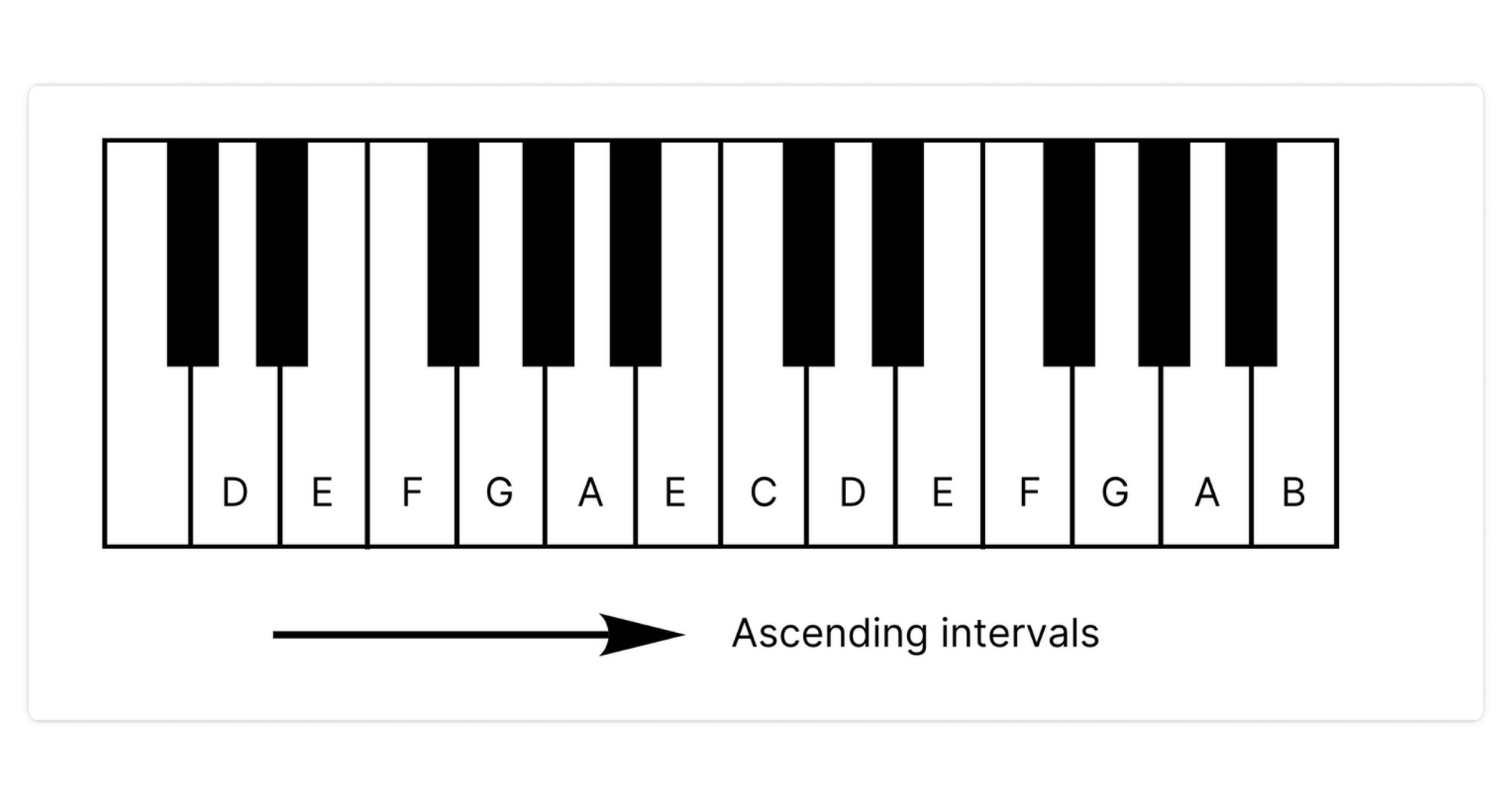

How to calculate the distance or interval between two notes?
When calculating the interval between two notes, it's crucial to consider the specific notes involved and keep in mind the aforementioned order or sequence of notes. Let's take an example of determining the distance – or interval – between A and B. Since A is the first note and serves as the starting point of the interval, we can write down the sequence of notes beginning with A and assign a number to each note, with A being note number one:

In the given image, B is the second note in the A/B interval, making it a second interval. Now, let's consider the interval between A and C. Since C is the third note, the interval between A and C is a third.
If we want to determine the interval between B and C, we follow a similar process. Since B is our starting point, we count from B while keeping the sequence of notes in mind:

In the image above, we can see that the interval B-C is a second.
As you can infer, these are the types of intervals:
- Second
- Third
- Fourth
- Fifth
- Sixth
- Seventh
- Octave. This one will represent the distance between low A and high A, since even though it's the same note, the pitch is different and there is thus a distance between the two notes:

Now let's dig deeper into each interval type.
What are the name of the intervals by type?
After considering all the points discussed earlier, I hope that what I'm about to share will come a bit naturally!
Seconds
In music, a second is the adjacent note, in ascending order, to the reference note, considering the sequence of notes we have been talking about.
Look at the image below:

Considering the explanation I just provided about seconds, I'll ask: How many seconds can you identify in that image?
The seconds you can find in that image are:
- C - D
- D - E
- E - F
- F - G
- G - A
- A - B
- B - C
Thirds
In music, a third is the third note in ascending order, to the reference note, considering the sequence of notes we have been talking about.
Let's look at another score:

How many thirds can you identify in that image?
Hopefully you see:
- C - E
- D - F
- E - G
- F - A
- G - B
- A - C
- B - D
Fourths
Following the same process, a fourth is the fourth note in ascending order, to the reference note.
Let's check on our score:

How many fourths can you identify in that image?
We see:
- C - F
- D - G
- E - A
- F - B
- G - C
- A - D
- B - E
Fifths
A fifths is the fifth note, in ascending order, to the reference note.
Let's check on our score:
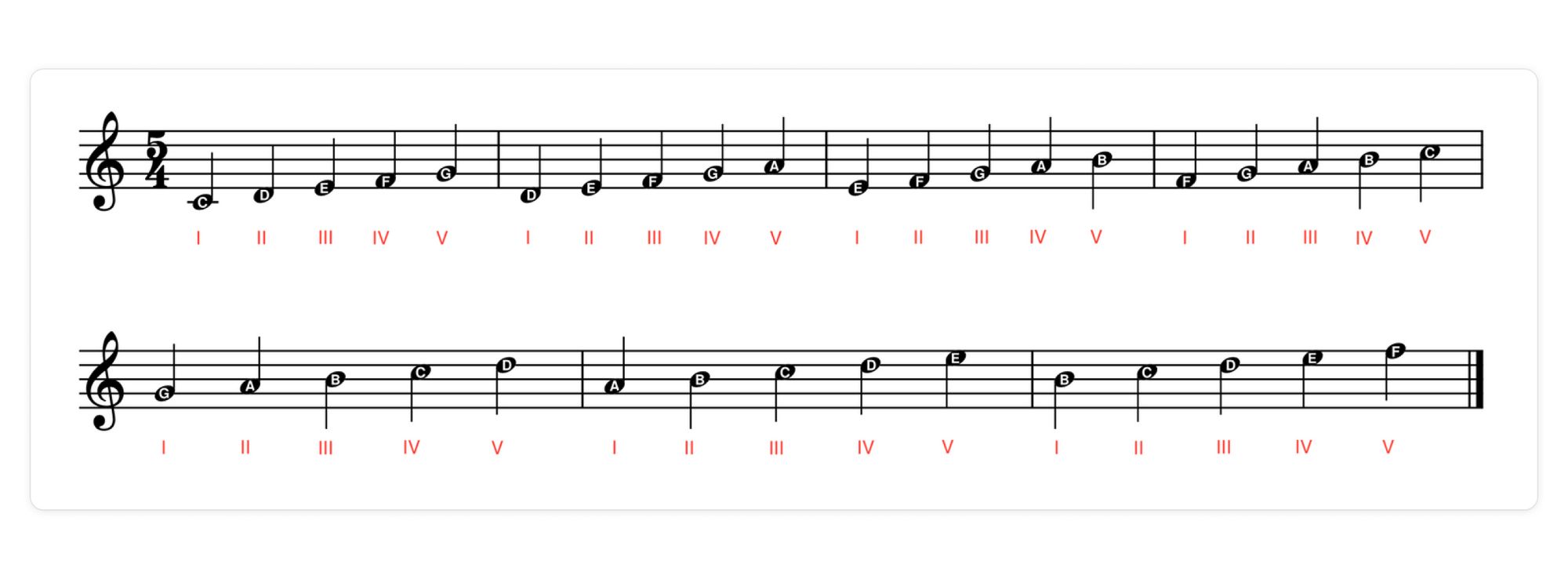
How many fifths can you identify in that image?
The fifths you can find in that image are:
- C - G
- D - A
- E - B
- F - C
- G - D
- A - E
- B - F
Sixths
A sixths is the sixth note, in ascending order, to the reference note.
Let's check on our score:

How many sixths can you identify in that image?
The sixths you can find in that image are:
- C - A
- D - B
- E - C
- F - D
- G - E
- A - F
- B - G
Sevenths
A seventh is the seventh note, in ascending order, to the reference note.
Let's check on our score:
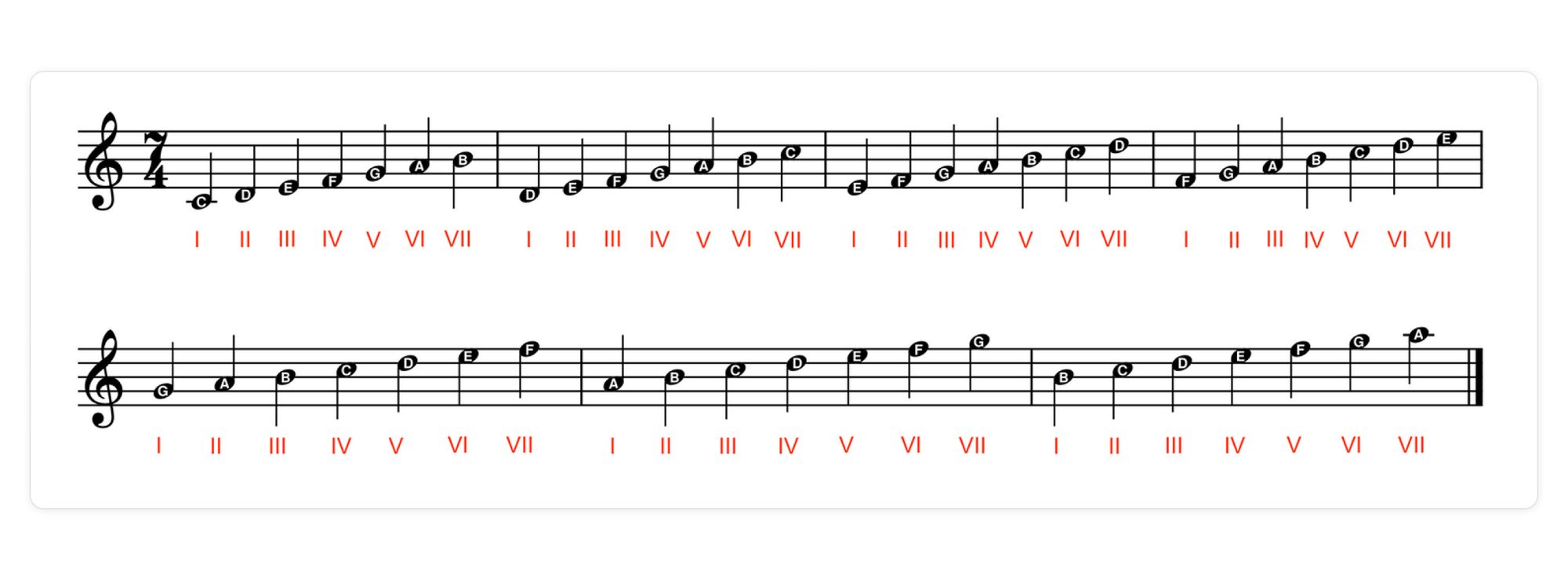
How many sevenths can you identify in that image?
The sevenths you can find in that image are:
- C - B
- D - C
- E - D
- F - E
- G - F
- A - G
- B - A
Octaves
A octaves is the eighth note, in ascending order, to the reference note.
Let's check on our score:
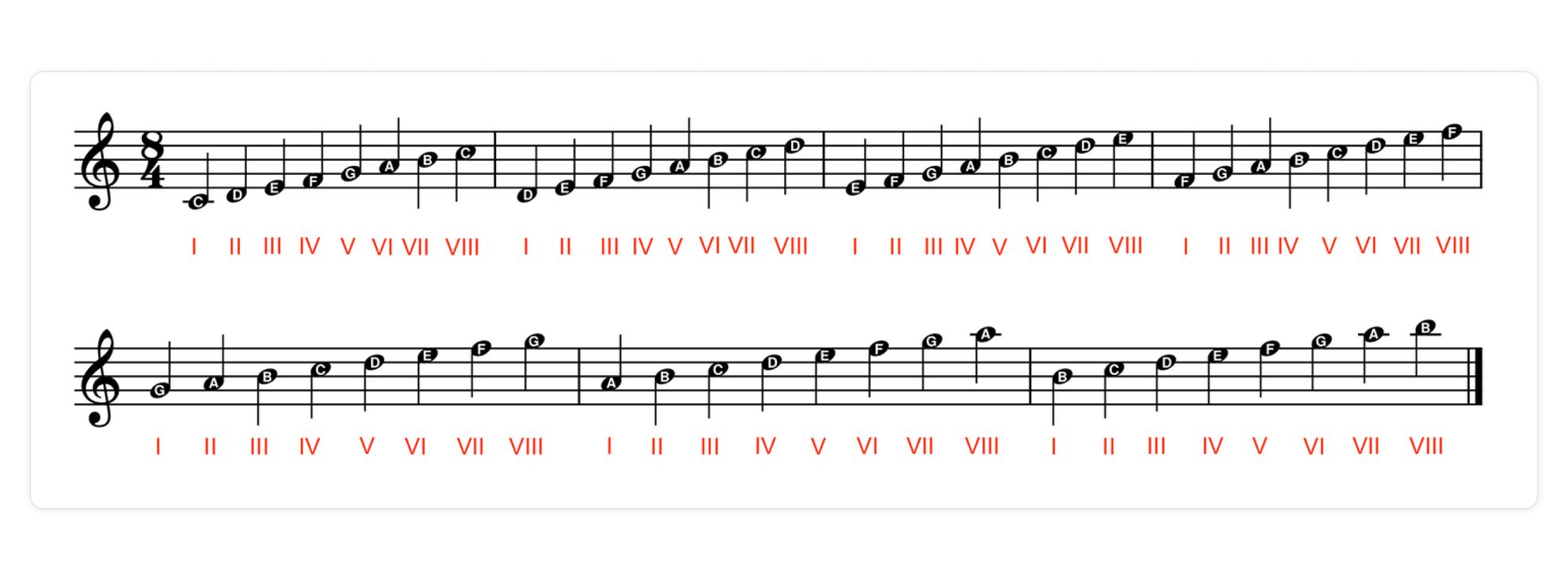
How many octaves can you identify in that image?
The octaves you can find in that image are:
- C - C
- D - D
- E - E
- F - F
- G - G
- A - A
- B - B
Bonus: The unison
There is another important concept regarding intervals that I must mention: the unison. When you play the same note twice (using the same spot on the keyboard), it creates a unison interval. Keep that in mind, as we'll talk about the use of this concept later in this article.
Does the alteration influence the type of interval?
When determining the type of interval, alterations do not matter. In simpler terms, whether you have C to D or C# to Db, both intervals are considered seconds. Therefore, the alterations do not affect the type of interval you are dealing with.
However, here's the catch: alterations do impact the quality of the interval. But what does the "quality" of an interval mean?
Quality of the intervals
So, alterations have an impact on the quality of an interval. Let's consider the intervals C-E and E-G as examples. Despite both being thirds, there is a distinction between these two thirds. The distinction lies in the distance between the notes in terms of semitones.
(If you're unfamiliar with the term "semitones" or would like to refresh your memory, I recommend checking out this article.)
Let's examine the distance between the intervals C-E and E-G.
- To go from C to E, we require 4 semitones, which we refer to as a major third.
- To go from E to G, only 3 semitones are needed, known as a minor third.
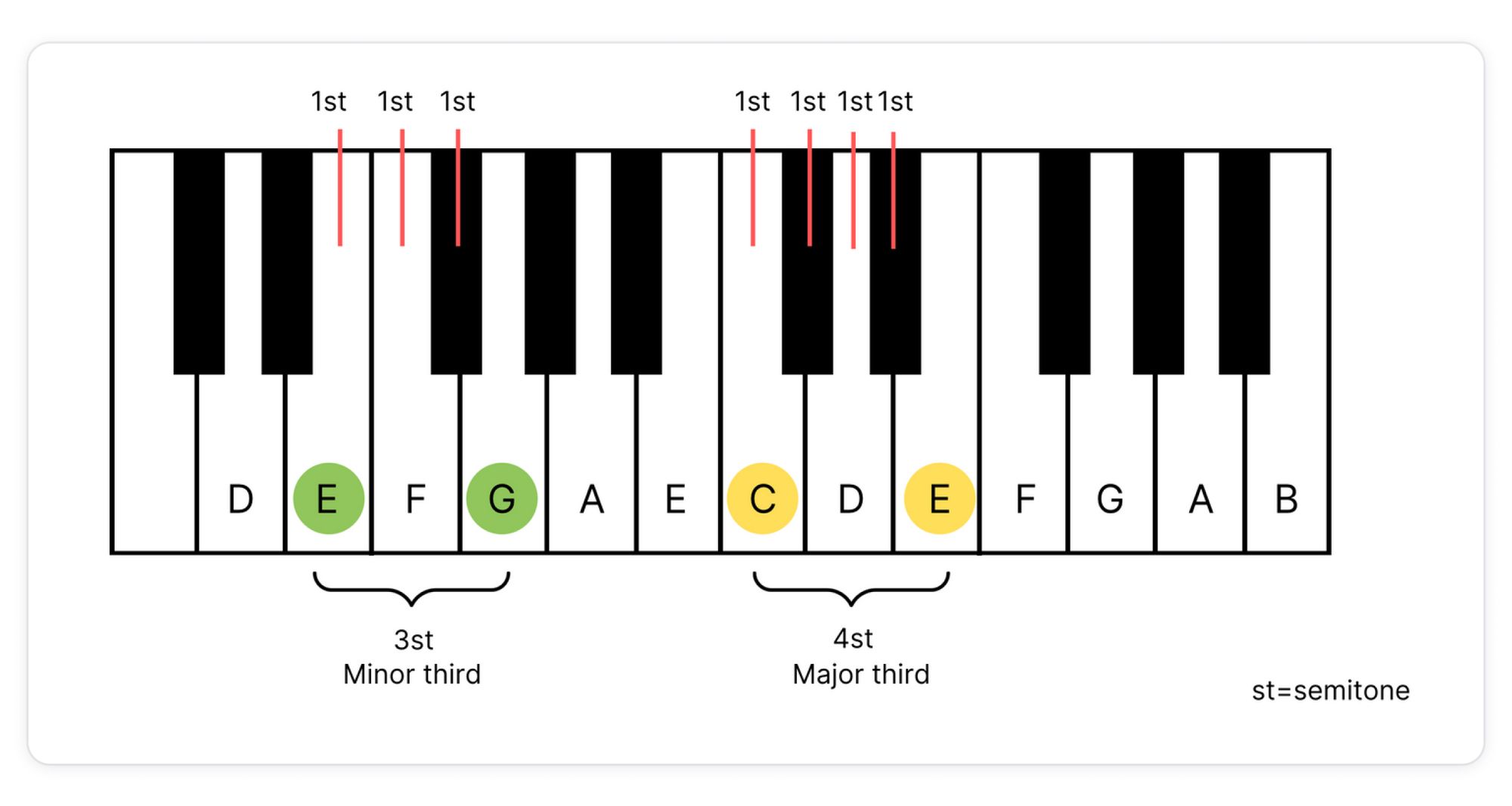
The process of determining the quality of an interval based on the number of semitones is known as qualifying the intervals. It involves specifying the interval's quality by considering the distance in terms of semitones.
All you need to know is in the table below. My advice is to learn and play this table:
| interval type | distance in semi-tones | Name | Example |
|---|---|---|---|
| unison | 0 | perfect unison | A-A |
| 1 | augmented unison | A-A# | |
| second | 1 | minor 2nd | E-F |
| 2 | major 2nd | B-C# | |
| 3 | augmented 2nd | Ab-B | |
| third | 2 | diminished 3rd | E-Gb |
| 3 | minor 3rd | F-Ab | |
| 4 | major 3rd | G-B | |
| 5 | augmented 3rd | C-E# | |
| fourth | 4 | diminished 4th | B-Eb |
| 5 | perfect 4th | G-C | |
| 6 | augmented 4th | F-B | |
| fifth | 6 | diminished 5th | F-Cb |
| 7 | perfect 5th | Eb-Bb | |
| 8 | augmented 5th | D-A# | |
| sixth | 7 | diminished 6th | C#-Ab |
| 8 | minor 6th | G-Eb | |
| 9 | major 6th | D-B | |
| 10 | augmented 6th | C-A# | |
| seventh | 9 | diminished 7th | C#-Bb |
| 10 | minor 7th | C-Bb | |
| 11 | major 7th | D-C# | |
| 12 | augmented 7th | C-B# |
What is the difference between minor thirds and augmented seconds?
To finish up, let's explore a situation where things can become a bit tricky. For instance, there are 3 semitones between E and G; likewise, there are 3 semitones between Ab and B. However, the first interval is referred to as a minor third, while the second interval is called an augmented second. What's the reasoning behind this?
Recall the initial step we discussed in this post: E to G. If we simply say "E, F, G," we are naming three notes, indicating that the interval between E and G is a third. If we go back to the table above, we find that a third with 3 semitones is classified as a minor third.
Now let's take Ab and B. Following the rule for intervals between notes, if we say "A, B," we are naming two notes, signifying that the interval between Ab and B is a second. Looking back at the table, we discover that a second with 3 semitones is known as an augmented second.
That's enough for now. Remember that in music, practice is key. For interval practice, take a look at this interactive page and start mastering this topic.
Articles on the series about intervals:
